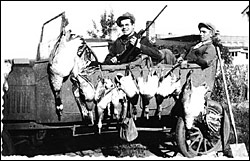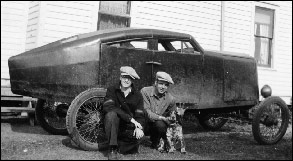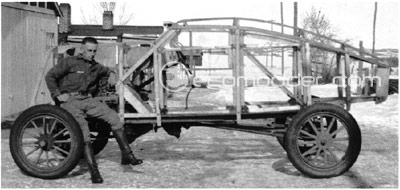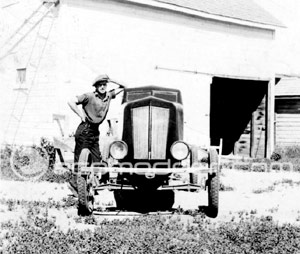Radical aeromodding of the DIY variety (e.g.
basjoos' Aerocivic) isn't a new pursuit. I learned this from a friend of mine, whose father - at the age of 17 in 1933 - redesigned & fabricated an aerodynamic body for his Ford Model T.
He transformed Ford's original high-drag disaster into a narrowed, boattailed, teardrop that was faster, more efficient and arguably better looking than the original.
And fortunately for posterity, he documented the transformation in photos:

 Harry Stevinson's handiwork: Before, with the original car out goose hunting;
Harry Stevinson's handiwork: Before, with the original car out goose hunting;
After, with the redesigned aerodynamic body.
- The end result was a custom car that would go 70 mph with its original engine. The Model T in stock form topped out around 45 mph.
- Fuel economy was similarly improved with the streamlined version. Harry reported achieving 38 mpg (US), vs. the original car's 25-30 mpg.
 Click image to zoom - Harry posing with the project under construction
Click image to zoom - Harry posing with the project under construction
- The body was built over wood frame & stringers, wood floor
- 4 person seating, 2 front, 2 rear
In the above image you can see the other major mod that improved the vehicle's efficiency: Harry installed
a second transmission from a Chevrolet, inline behind the original Model T unit. This gave the car 7 forward speeds, and 5 reverse.
Of course not all the gear combinations would have been practical or even usable, but with some experience and forethought, the driver could pick the best one for the job.
Stopping the car was done using the transmission's service (shaft) brake and downshifting, rather than the stock Model T's rear drum brakes. The brake shoes tended to get worn down quickly anyway in the Canadian prairie dust & mud.
 Click to zoom: Reduced frontal area... and custom grill.
Click to zoom: Reduced frontal area... and custom grill.
- despite small windshield area, forward visibility was fine since the driver sat close to the glass
- a gas torch served as the front window defroster
Harry's efficiency interests didn't stop with the aero Model T. In later years, he equipped an Oldsmobile with a basic fuel economy meter: a graduated glass cylinder (in the cabin) which fed fuel to the carburetor. He used it to monitor fuel consumption on the road.
Harry was also an early adopter of the original VW Beetle. Even then, he was aware of its missed potential: despite its relatively good fuel efficiency (for its time), his son Tom tells me he remembers Harry explaining that its poor aerodynamics held it back from even better MPG.
The guy was a true ecomodding pioneer.
---
For those who are interested, I posted the original version of this story on MetroMPG.com, where you can find more info than appears here.